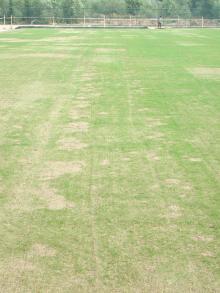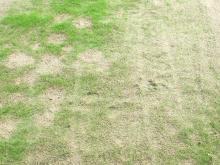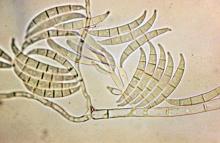See:
Hosts Many. Ryegrass and bluegrass species are particularly susceptible to damping-off.
Cause Pythium sp., Rhizoctonia sp., Fusarium, and other fungi. Damping-off is quite common in Oregon in wet weather on newly seeded lawns, either soon after seed germinates or seedlings emerge. Seeding rate is a critical factor when preventing damping-off. When seed is applied in excess, the turf will not have enough resources (water or nutrients) to grow, which will increase susceptibility to this disease. In addition, excessive seeding rates allow the hyphae of the pathogen(s) to easily move from one turf plant to the next because of close proximity.
Fusarium survives in the soil as thick-walled, dormant chlamydospores, which germinate in response to exudates from nearby plant roots. Hyphae then penetrate the roots, colonize the cortex, and move into the xylem tissue. Small spores (microconidia) are produced and carried up into the plant. Damping-off caused by Fusarium is prevalent during cool, wet conditions.
Rhizoctonia survives in the soil as sclerotia or as mycelium colonizing bits of organic matter. Roots become infected as they grow past these structures. The fungus then grows along the root surface, forms an aggregation called an infection cushion, pushes into the root where it colonizes, and spreads and kills the tissue. The fungus can form knots of mycelium that develop into sclerotia. These are released into the soil as the plant debris decomposes. Damping-off caused by Rhizoctonia (or Pythium) occurs during hot, wet conditions that are typical during summer seeding when frequent irrigation is required. Avoid seeding during periods of extreme temperatures will help avoid this disease.
Symptoms Young plants wither, turn brown, and die, leaving irregular bare patches 1 inch or more in diameter.
Cultural control
- Seeding in the spring (prior to Memorial Day) and in the fall (after Labor Day) will promote turfgrass establishment and greatly reduce the development of damping-off by avoiding extreme temperatures (hot or cold).
- Provide good drainage during initial soil preparation.
- Avoid excessive watering after seeding.
- Avoid excess seeding rates (for example, max seeding rates are 11 lb of perennial ryegrass/1,000 sq ft and 3 lb of Kentucky bluegrass/1,000 sq ft).
Chemical control To prevent developing resistant fungi, alternate or tank-mix materials from different groups with different modes of action.
- Use treated seed, or treat seed with:
- Allegiance-FL at 1.5 fl oz/100 lb seed. Effective against Pythium only. Group 4 fungicide.
- Apron XL LS at 0.64 to 1.28 fl oz/100 lb seed. Effective against Pythium only. Group 4 fungicide.
- Maxim XL at 0.167 to 0.334 fl oz/100 lb seed. Group 12 fungicide.
- Thiram Granuflo at 5.3 oz/100 lb seed. Group M3 fungicide.
- For Rhizoctonia and Fusarium, spray with:
- Mancozeb 75% (Fore, Manzate, and Protect DF) at 4 to 8 oz/1,000 sq ft. Group M3 fungicide. 24-hr reentry.
- For Pythium, spray with:
- Appear at 6 to 8 fl oz/1,000 sq ft. Group P7 fungicide. Reentry when sprays have dried.
- Banol at 1.3 to 4 fl oz/1,000 sq ft. Group 28 fungicide. 12-hr reentry.
- Chipco Signature at 4 to 8 oz/1,000 sq ft. Group P7 fungicide. 48-hr reentry.
- Fiata at 5 to 15 fl oz/1,000 sq ft. Do not mow or irrigate until sprays have dried. Group P7 fungicide. 4-hr reentry.
- Fosphite at 2 to 3 fl oz/1,000 sq ft. Do not use copper products within 20 days of treatment and do not use spray adjuvants. Do not mow or irrigate until sprays have dried. Group P7 fungicide. 4-hr reentry.
- Mefenoxam 2 AQ at 0.49 to 0.98 fl oz in 1 to 5 gal water per 1,000 sq ft. Group 4 fungicide. 48-hr reentry.
- Phostrol at 4 to 8 fl oz/1,000 sq ft. Group P7 fungicide. 4-hr reentry.
- Proplant at 1.3 to 4 fl oz/2 to 5 gal water/1,000 sq ft. Group 28 fungicide. 12-hr reentry.
- Segway SC at 0.45 to 0.9 fl oz/1,000 sq ft. Do not make more than three (3) applications per season. Group 21 fungicide. 12-hr reentry.
- Subdue MAXX at 0.5 to 1 fl oz/1 to 5 gal water/1,000 sq ft. Group 4 fungicide. 48-hr reentry.
- Terrazole L at 1.5 to 3 fl oz in 2 to 5 gal water/1,000 sq ft. For tees and greens only. Group 14 fungicide. 12-hr reentry.
- Truban 30 WP at 2 to 4.5 oz/5 to 10 gal water. Irrigate after application. Group 14 fungicide. 12-hr reentry.
Combination Fungicides
- Stellar at 1.2 fl oz/1,000 sq ft. Group 28 + 43 fungicide. 12-hr reentry.
Biological control Use in conjunction with other control tactics.
- LALStop G46 WG (Clonostachys rosea [formerly Gliocladium catenulatum] strain J1446) at 0.04 to 0.4 oz/1,000 sq ft. Do not use with other products in the tank. 4-hr reentry. O
- LALStop K61 WP (Streptomyces Strain K61) at 0.01 to 1.75 oz/1,000 sq ft. Apply with enough water to move product into the root zone. Can be used as a soil spray or drench. 4-hr reentry. O
- Mycostop (Streptomyces Strain K61) at 0.176 oz/1,000 sq ft. Apply with enough water to move product into the root zone. Can be used as a soil spray or drench. 4-hr reentry. O
- SoilGard (Gliocladium virens strain GL-21) at 2 to 4 oz/1,000 sq ft. Group BM02 fungicide. 4-hr reentry. O
- Stargus (Bacillus amyloliquefaciens strain F727) at 2 to 4 quarts/100 gal water plus a nonionic surfactant as a soil drench. Use 2 gal solution/1,000 sq ft. Group BM02 fungicide. 4-hr reentry. O
- Triathlon BA (Bacillus amyloliquefaciens strain D747) at 1 to 4 fl oz/1,000 sq ft. Group BM02 fungicide. 4-hr reentry. O
- Zio (Pseudomonas chlororaphis strain AFS009) at 1.8 to 6.0 oz/1,000 sq ft. when ground temperature is > 45oF. 4-hr reentry. O
Reference Cook, P.J., Landschoot, P.J., and Schlossberg, M.J. 2009. Inhibition of Pythium spp. and suppression of Pythium blight of turfgrasses with phosphonate fungicides. Plant Disease 93:809-814.




